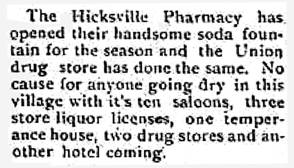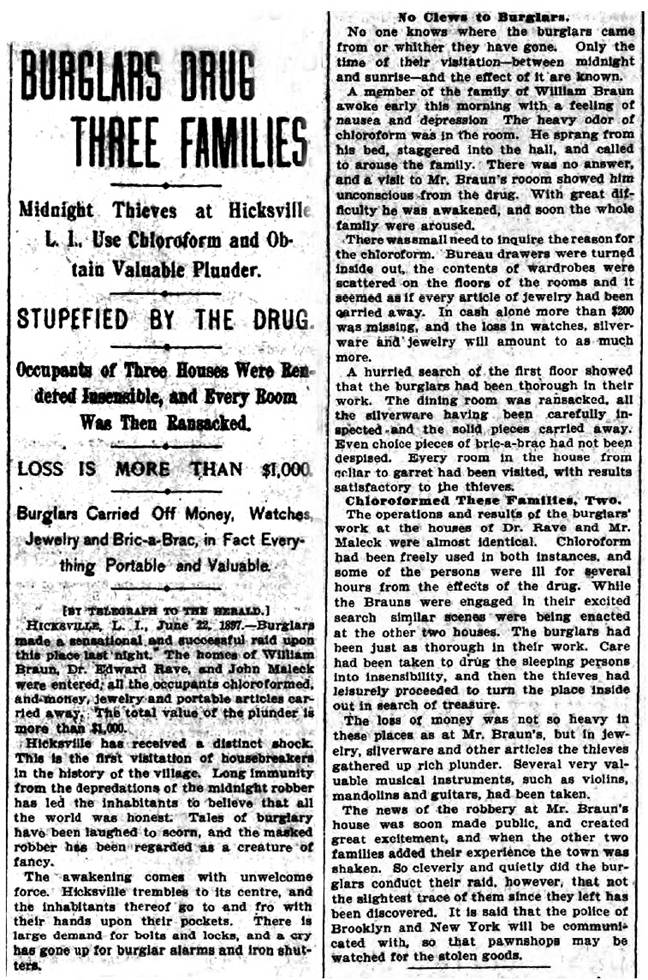Life in Hicksville, as Experienced by a Village Doctor
Today, it may seem like Hicksville's Golden Age, but one wonders if Edward Rave thought that at the time. He spent most his work time far from elegance and beauty, for every day he tended to the needs of the working people, the elderly, and perhaps the indigent. We do not have logs of his appointments and emergency calls, but from scattered articles in old newspapers, we can learn a fair bit about village life in this era. It will not be a complete picture, but rather a mosaic, with plenty of tiles now missing.
Some of the news items we discover may at first seem insignificant. For example, Brooklyn Life regularly tracked the spread of the automobile across Long Island, and in the third week of May, 1910, it told its readers that Edward G. Rave, M.D. had registered his Maxwell. (Yes, fellow old-timers, that is the kind of automobile that Eddie 'Rochester' Anderson hypothetically drove for too many years on behalf of Jack Benny.)

Advertisement for 1909 Maxwell D-A
Starting any car of the era meant hand-cranking it, and driving it was arduous - power steering would not be invented until the 1950s. Edward Rave was 66 years old in 1910. After each visit, he had to crank up the Maxwell again, and wrangle it to wherever the next patient was. Frequently called to consult on difficult cases, he often drove to Queens, or Suffolk. Being a doctor in this particular Golden Age took determination and stamina.
*
Note that many Long Island newspapers printed earlier than, say, 1885 either have not survived, or are not available online. Here are some glimpses of Long Island life as Edward Rave knew it, starting with 1888:
- In July 1888, Dr. Rave and his wife returned to Europe for a vacation. Among the things they did there was go to Carlsbad for the mineral baths. During their absence, his young assistant, Dr. Taliaferro (who would soon have his own local practice) looked after Dr. Rave's patients.
- In December 1888, Dr. Rave was called to Breslau (now Lindenhurst). The horse-drawn stage coach that ran between Hicksville and the south shore had overturned, badly injuring five people. He would travel there repeatedly for more than a week, continuing to treat the most seriously injured.
- A few months later, the newspaper announced that Dr. Rave was importing clean cotton from Germany, for local doctors who needed it to staunch blood during surgeries.
- Not long after that, Hicksville and the surrounding area were hit by simultaneous waves of scarlet fever and diphtheria. The newspapers commented on how busy Dr. Rave was in consequence, mentioning his great success in treating the latter.
- In June of 1891, in his capacity as LIRR surgeon, Dr. Rave was called a short distance to his hometown depot, where a freight train awaited him. Some miles back, a crew member had been partially scalped by a malfunctioning lever on a track switch; the train hurried to Hicksville to get Dr. Rave's help as soon as possible. Fortunately, he was able to reattach the man's scalp.
- That July - and probably in every July - he set many broken limbs and sprains, because young people climbed trees to pick ripe cherries, slipped, and fell to the ground all over Hicksville and Plainview. That year, Hicksville also saw a spate of feverish young boys' passing out for hours at a time in the summer heat. The likely cause was said to be their feasting on unwashed cherries, and drinking lots of nearby stagnant water.
- By 1894, Rave's Union Drug Store was offering smallpox vaccinations for infants on every Tuesday.
- Just before Easter 1895, Rave was summoned to Bellmore, to treat an attempted suicide. A man had both taken poison and shot himself in the head, but he had survived. Dr. Rave successfully removed the bullet from the man's brain. I have found no report on the attempt's long-term effect upon the unfortunate man.
- The following month, the Union Drug Store opened its soda fountain for its second season.

Huntington Long-Islander, May 16, 1894

Huntington Long-Islander, May 24, 1895
Frankly, I am not certain why a soda fountain could not open until the nearby ponds were thawing. Could it be that local spring water was offered as refreshment?
*
Thus far, we have learned some things about life in old Hicksville. Because the LIRR did not directly link Hicksville to either shore, the village was still served by a stage coach that went north and south. Kids were kids even back then, and sometimes they did stupid things. Nineteenth century medicine had limitations and strengths. Soda fountains were a new fad. All of these things seem perfectly ordinary.
Also ordinary, but nonetheless disturbing, were the problems of the age, which were as rampant and serious in Hicksville as they were anywhere. Due to rail and farm accidents, serious wounds and loss of limbs were commonplace - yet before Dr. Rave took action, clean bandage material apparently was not readily available in the village. Attempted and completed suicides were not rare; most weekly editions of the Long-Islander newspaper reported one's having occurred in the area.
I am not suggesting that the village was a bad place at this time. Rather, I mean to point out that the era that some call its Golden Age was not especially golden for the majority of Hicksvillians. To them, it was just an Ordinary Age.
*
Let's look now at some of the more gripping news items that mention Edward Rave:
- In February 1896, during a sustained period of frigid weather, the Town's Overseer of the Poor told Dr. Rave to check on two elderly siblings who had not been seen around Hicksville for some time. In their unheated cabin, the doctor found a man who sat next to a stove without fuel, in a kitchen without food. Upstairs lay the body of the man's sister, literally frozen solid. Her brother refused to let anyone else into the cabin, and he refused to leave, not wanting to abandon his deceased sister's body.
- The next winter brought a similar call. A homeless woman, in her twenties, had lain down next to a road and fallen asleep. She froze to death.
- In August 1902, he went to check on a young mother. Her three little children were waiting for her to awaken, and the youngest cuddled close against her. Alas, she had starved to death, at the age of thirty-two.
*
In 1897, Dr. Rave, his family, and some of their neighbors endured a horrible experience.

New York Herald, June 23, 1897
*
By 1900, bicycling was, to use 21st century lingo, definitely trending. One June night, a number of young cyclists were racing down Broadway in the dark. None of them used lights or sounded warning bells, as required after dark by local ordinance. They did not slow as they approached Manetto Hill Road (now Old Country Road). As they raced across it, six of them were struck sideways by a horse-drawn cart. One of the cart's shafts - a pole that juts forward from a cart, to which the horse's harness is attached - impaled one of the cyclists. The cart's driver quickly fetched Dr. Rave, but the young man had already died. The cart driver was exonerated, and the surviving cyclists were assessed fines.
During 1901's quail hunting season, Edward Rave was called to tend to a hunter, shot when a hunting companion tripped and accidentally discharged his gun. The man had died instantly. I must note that this was a fairly regular occurrence; even Young Doctor Rave once wounded a friend while climbing over a fence in search of game.
In 1902, the Southern New York Volunteer Firemens Association held its annual convention in Hicksville. Arriving delegates at the railroad station were so excited that they rushed forward, accidentally pushing a visiting Deputy Chief in front of the departing train. Both his legs were severed - and no one in the crowd administered first aid. The man sat in shock, staring ahead blankly, and expired just as Dr. Rave arrived to try to save him.
One June day in 1908, physicians from surrounding towns, including both of Hicksville's Drs. Rave, were called to the site of a collision southwest of Hicksville. Two autos had been racing along Bethpage Turnpike. One kicked up so much dust behind it that its competitor could not be seen by other traffic. An approaching car drove into the dust cloud, colliding with it head-on. One person died; six others sustained serious injuries. The other car in the race just kept going.
These events make Hicksville seem a darker place. Even with an Overseer of the Poor, people regularly starved and froze to death. The chloroform incident left the victims, and for that matter, most townspeople, terrified. Thoughtless and reckless behavior abounded, often with gruesome and fatal consequences.
I do not mention these events to demean Hicksville - but when we wax nostalgic for the past, we sometimes need to be reminded that life then was complex, and at times far from picture-perfect.
***

